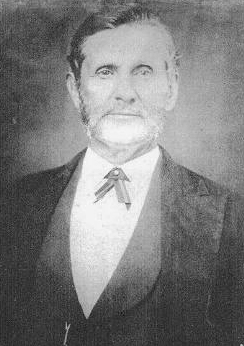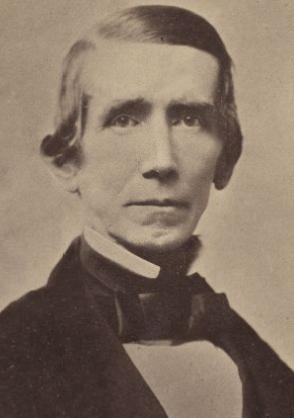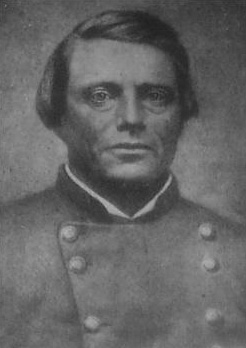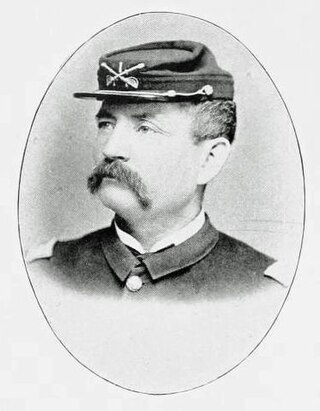
Walter Paye Lane was a Confederate general during the American Civil War who also served in the armies of the Republic of Texas and the United States of America.

General Edmund Kirby Smith was a senior officer of the Confederate States Army who commanded the Trans-Mississippi Department from 1863 to 1865. Before the American Civil War, Smith served as an officer of the United States Army.

James Pinckney Henderson was an American and Republic of Texas lawyer, politician, and soldier, and the first governor of the State of Texas.

Brigadier-General Benjamin McCulloch was a soldier in the Texas Revolution, a Texas Ranger, a major-general in the Texas militia and thereafter a major in the United States Army during the Mexican–American War, sheriff of Sacramento County, a U.S. marshal, and a brigadier-general in the army of the Confederate States during the American Civil War. He owned at least 91 slaves.

The Confederate States Marine Corps (CSMC), also referred to as the Confederate States Marines, was a branch of the Confederate Navy during the American Civil War. It was established by an act of the Provisional Congress of the Confederate States on March 16, 1861. The Corps' manpower was initially authorized at 45 officers and 944 enlisted men, and was increased on September 24, 1862, to 1,026 enlisted men. The organization of the Corps began at Montgomery, Alabama, and was completed at Richmond, Virginia, when the capital of the Confederate States was moved to that location. The headquarters and main training facilities remained in Richmond throughout the war, located at Camp Beall on Drewry's Bluff and at the Gosport Shipyard in Portsmouth, Virginia. The last Marine unit surrendered to the Union army on April 9, 1865, with the Confederacy itself capitulating a month later.
Henry Percy Brewster was a lawyer, statesman, and soldier from Texas. He fought in the Texas Revolution, and as a colonel in the Confederate Army during the Civil War.

John Salmon Ford, better known as "Rip" Ford, was a member of the Republic of Texas Congress and later the Texas Senate, and mayor of Brownsville, Texas. He was also a Texas Ranger, a Confederate colonel, a doctor, a lawyer, and a journalist and newspaper owner. Ford commanded men during the Antelope Hills expedition, and he later commanded the Confederate forces in what was arguably the last engagement of the American Civil War, the Battle of Palmito Ranch on May 12–13, 1865. It was a Confederate victory, but as it occurred more than a month after Robert E. Lee's surrender, it did not affect the war's outcome.

Alfonso Parcutt Steele was one of the last remaining survivors of the Battle of San Jacinto during the Texas Revolution, and second-to-last survivor of Sam Houston's Army.

Thomas Green was an American soldier and lawyer, who took part in the Texan Revolution of 1835–36, serving under Sam Houston, who rewarded him with a land grant. Green was clerk of the Texas Supreme Court until the outbreak of the Civil War, when he became a Confederate cavalry leader. After winning several victories, including the Battle of Valverde and the recapture of Galveston, he was promoted brigadier and assigned command of the cavalry division of the Trans-Mississippi Department. In the Red River Campaign, he was mortally wounded while charging a fleet of Federal gunboats. The Union naval commander David Dixon Porter paid tribute to Green as a serious loss to the Confederacy.

Humphrey Marshall was an American lawyer, politician, and military official from Kentucky. During the Antebellum era, he served four terms in the United States House of Representatives, interrupted by a brief stint as ambassador to China. When the American Civil War broke out, he sided with the Confederacy, becoming a brigadier general in the CS Army and then a Confederate Congressman.

Richardson A. Scurry was a Texas politician and a Democratic member of the United States House of Representatives.
The Texas Military Forces (TXMF) are the principal instrument through which the Texas Military Department (TMD) executes security policy for Texas, which has the second-largest population and border in the United States, and the 9th-largest economy in the world.

The Texian Army, also known as the Revolutionary Army and Army of the People, was the land warfare branch of the Texian armed forces during the Texas Revolution. It spontaneously formed from the Texian Militia in October 1835 following the Battle of Gonzales. Along with the Texian Navy, it helped the Republic of Texas win independence from the Centralist Republic of Mexico on May 14, 1836 at the Treaties of Velasco. Although the Texas Army was officially established by the Consultation of the Republic of Texas on November 13, 1835, it did not replace the Texian Army until after the Battle of San Jacinto.

The Choctaw in the American Civil War participated in two major arenas—the Trans-Mississippi and Western Theaters. The Trans-Mississippi had the Choctaw Nation. The Western had the Mississippi Choctaw. The Choctaw Nation had been mostly removed west prior to the War, but the Mississippi Choctaw had remained in the east. Both the Choctaw Nation and the Mississippi Choctaw would ultimately side with the Confederate States of America.

John Austin Wharton was distinguished Texian statesman, lawyer, and soldier. He served as Adjutant General at the Battle of San Jacinto. In a eulogy at his grave, Republic of Texas President David G. Burnet said of him, "The keenest blade on the field of San Jacinto is broken." He died a bachelor on December 17, 1838, while serving as a member of the Texas Congress. His nephew, John A. Wharton, who would go on to be a Confederate Army general, was named for him.
José Gregorio Esparza, also known as Gregorio Esparza, was the last Texan defender to enter the Alamo during the early days of March 1836 in the Siege of the Alamo and was the only one that was not burned in the pyres. He had brought his family into the Alamo compound along with him. They were able to survive the battle and were not executed by the conquering army.

The 32nd Texas Cavalry Regiment, sometimes incorrectly named Andrews's 15th Texas Cavalry Regiment, was a unit of volunteer cavalry mustered into the Confederate States Army in May 1862 and which fought during the American Civil War. The regiment was formed around companies from Richard Phillip Crump's 1st Texas Cavalry Battalion which fought in Indian Territory and at Pea Ridge. Many of the soldiers died of disease in the unhealthy camps near Corinth, Mississippi. The cavalrymen were dismounted in July 1862 and served as infantry for the rest of the war. The regiment fought at Richmond, Ky., Stones River, and Chickamauga in 1862–1863, in the Meridian and Atlanta campaigns and at Nashville in 1864, and at Spanish Fort and Fort Blakeley in 1865. The regiment's 58 surviving members surrendered to Federal forces on 9 May 1865.

Henry Carroll was an American brigadier general of the American Civil War and the Spanish–American War. He was known for commanding the 1st Brigade of the Cavalry Division during the Battle of San Juan Hill but was wounded during the battle and had to be succeeded by Brigadier General Samuel S. Sumner.
The 35th (Likens') Texas Cavalry Regiment was a unit of mounted volunteers from Texas that fought in the Confederate States Army during the American Civil War. The regiment was formed by consolidating Likens' Texas Cavalry Battalion and Burns' Texas Cavalry Battalion in October 1863. James B. Likens was appointed to lead the new unit, which was in a brigade first led by Hamilton P. Bee and later by Arthur P. Bagby Jr.. It fought at Mansfield and Pleasant Hill in 1864. The regiment moved to Beaumont, Texas, in early 1865, and surrendered there in June 1865.















